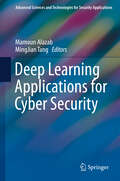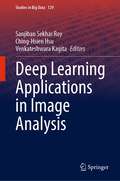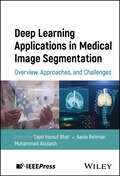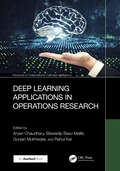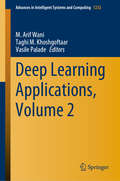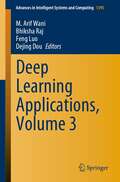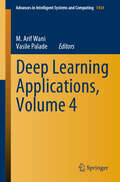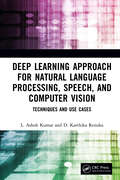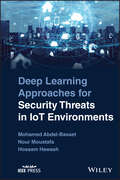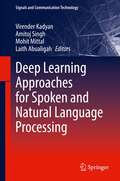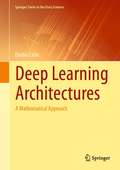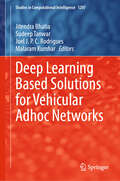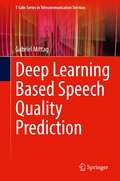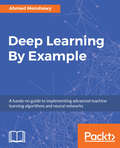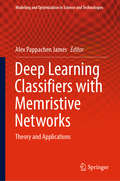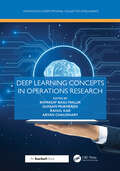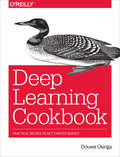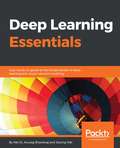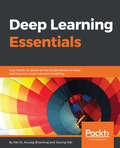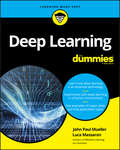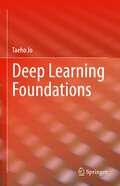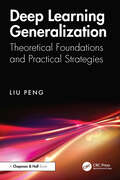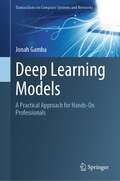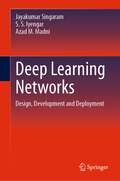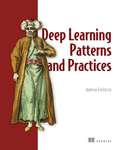- Table View
- List View
Deep Learning Applications for Cyber Security (Advanced Sciences and Technologies for Security Applications)
by Mamoun Alazab MingJian TangCybercrime remains a growing challenge in terms of security and privacy practices. Working together, deep learning and cyber security experts have recently made significant advances in the fields of intrusion detection, malicious code analysis and forensic identification. This book addresses questions of how deep learning methods can be used to advance cyber security objectives, including detection, modeling, monitoring and analysis of as well as defense against various threats to sensitive data and security systems. Filling an important gap between deep learning and cyber security communities, it discusses topics covering a wide range of modern and practical deep learning techniques, frameworks and development tools to enable readers to engage with the cutting-edge research across various aspects of cyber security. The book focuses on mature and proven techniques, and provides ample examples to help readers grasp the key points.
Deep Learning Applications in Image Analysis (Studies in Big Data #129)
by Ching-Hsien Hsu Sanjiban Sekhar Roy Venkateshwara KagitaThis book provides state-of-the-art coverage of deep learning applications in image analysis. The book demonstrates various deep learning algorithms that can offer practical solutions for various image-related problems; also how these algorithms are used by scientists and scholars in industry and academia. This includes autoencoder and deep convolutional generative adversarial network in improving classification performance of Bangla handwritten characters, dealing with deep learning-based approaches using feature selection methods for automatic diagnosis of covid-19 disease from x-ray images, imbalance image data sets of classification, image captioning using deep transfer learning, developing a vehicle over speed detection system, creating an intelligent system for video-based proximity analysis, building a melanoma cancer detection system using deep learning, plant diseases classification using AlexNet, dealing with hyperspectral images using deep learning, chest x-ray image classification of pneumonia disease using efficient net and inceptionv3.The book also addresses the difficulty of implementing deep learning in terms of computation time and the complexity of reasoning and modelling different types of data where information is currently encoded. Each chapter has the application of various new or existing deep learning models such as Deep Neural Network (DNN) and Deep Convolutional Neural Networks (DCNN). The detailed utilization of deep learning packages that are available in MATLAB, Python and R programming environments have also been discussed, therefore, the readers will get to know about the practical implementation of deep learning as well. The content of this book is presented in a simple and lucid style for professionals, nonprofessionals, scientists, and students interested in the research area of deep learning applications in image analysis.
Deep Learning Applications in Medical Image Segmentation: Overview, Approaches, and Challenges
by Sajid Yousuf Bhat Aasia Rehman Muhammad AbulaishApply revolutionary deep learning technology to the fast-growing field of medical image segmentation Precise medical image segmentation is rapidly becoming one of the most important tools in medical research, diagnosis, and treatment. The potential for deep learning, a technology which is already revolutionizing practice across hundreds of subfields, is immense. The prospect of using deep learning to address the traditional shortcomings of image segmentation demands close inspection and wide proliferation of relevant knowledge. Deep Learning Applications in Medical Image Segmentation meets this demand with a comprehensive introduction and its growing applications. Covering foundational concepts and its advanced techniques, it offers a one-stop resource for researchers and other readers looking for a detailed understanding of the topic. It is deeply engaged with the main challenges and recent advances in the field of deep-learning-based medical image segmentation. Readers will also find: Analysis of deep learning models, including FCN, UNet, SegNet, Dee Lab, and many moreDetailed discussion of medical image segmentation divided by area, incorporating all major organs and organ systemsRecent deep learning advancements in segmenting brain tumors, retinal vessels, and inner ear structuresAnalyzes the effectiveness of deep learning models in segmenting lung fields for respiratory disease diagnosisExplores the application and benefits of Generative Adversarial Networks (GANs) in enhancing medical image segmentationIdentifies and discusses the key challenges faced in medical image segmentation using deep learning techniquesProvides an overview of the latest advancements, applications, and future trends in deep learning for medical image analysis Deep Learning Applications in Medical Image Segmentation is ideal for academics and researchers working with medical image segmentation, as well as professionals in medical imaging, data science, and biomedical engineering.
Deep Learning Applications in Operations Research (Advances in Computational Collective Intelligence)
by Gunjan Mukherjee Aryan Chaudhary Biswadip Basu Mallik Rahul KarThe model-based approach for carrying out the classification and identification of tasks has led to progression of the machine learning paradigm in diversified fields of technology. Deep Learning Applications in Operations Research presents the varied applications of this model-based approach. Apart from the classification process, the machine learning (ML) model has become effective enough to predict future trends of any sort of phenomenon. Such fields as object classification, speech recognition, and face detection have sought extensive applications of artificial intelligence (AI) and machine learning as well. The application of AI and ML has also become increasingly common in the domains of agriculture, health sectors, and insurance.Operations research is the branch of mathematics used to perform many operational tasks in other allied domains, and the book explains how the implementation of automated strategies in optimization and parameter selection can be carried out by AI and ML. Operations research has many beneficial aspects to aid in decision making. Arriving at the proper decision depends on a number of factors; this book examines how AI and ML can be used to model equations and define constraints to solve problems more easily and discover proper and valid solutions. This book also looks at how automation plays a significant role in minimizing human labor and thereby minimizes overall time and cost. Case studies examine how to streamline operations and unearth data to make better business decisions. The concepts presented in this book can bring about and guide unique research directions to the future application of AI-enabled technologies.
Deep Learning Applications, Volume 2 (Advances in Intelligent Systems and Computing #1232)
by Vasile Palade M. Arif Wani Taghi M. KhoshgoftaarThis book presents selected papers from the 18th IEEE International Conference on Machine Learning and Applications (IEEE ICMLA 2019). It focuses on deep learning networks and their application in domains such as healthcare, security and threat detection, fault diagnosis and accident analysis, and robotic control in industrial environments, and highlights novel ways of using deep neural networks to solve real-world problems. Also offering insights into deep learning architectures and algorithms, it is an essential reference guide for academic researchers, professionals, software engineers in industry, and innovative product developers.
Deep Learning Applications, Volume 3 (Advances in Intelligent Systems and Computing #1395)
by Bhiksha Raj Dejing Dou M. Arif Wani Feng LuoThis book presents a compilation of extended version of selected papers from the 19th IEEE International Conference on Machine Learning and Applications (IEEE ICMLA 2020) and focuses on deep learning networks in applications such as pneumonia detection in chest X-ray images, object detection and classification, RGB and depth image fusion, NLP tasks, dimensionality estimation, time series forecasting, building electric power grid for controllable energy resources, guiding charities in maximizing donations, and robotic control in industrial environments. Novel ways of using convolutional neural networks, recurrent neural network, autoencoder, deep evidential active learning, deep rapid class augmentation techniques, BERT models, multi-task learning networks, model compression and acceleration techniques, and conditional Feature Augmented and Transformed GAN (cFAT-GAN) for the above applications are covered in this book. Readers will find insights to help them realize novel ways of using deep learning architectures and algorithms in real-world applications and contexts, making the book an essential reference guide for academic researchers, professionals, software engineers in the industry, and innovative product developers.
Deep Learning Applications, Volume 4 (Advances in Intelligent Systems and Computing #1434)
by Vasile Palade M. Arif WaniThis book presents a compilation of extended versions of selected papers from 20th IEEE International Conference on Machine Learning and Applications (IEEE ICMLA 2021). It focuses on deep learning networks and their applications in domains such as healthcare, security and threat detection, fault diagnosis and accident analysis, and robotic control in industrial environments. It highlights novel ways of using deep neural networks to solve real-world problems, and also offers insights into deep learning architectures and algorithms, making it an essential reference guide for academic researchers, professionals, software engineers in industry, and innovative product developers. The book is fourth in the series published since 2017.
Deep Learning Approach for Natural Language Processing, Speech, and Computer Vision: Techniques and Use Cases
by L. Ashok Kumar D. Karthika RenukaDeep Learning Approach for Natural Language Processing, Speech, and Computer Vision provides an overview of general deep learning methodology and its applications of natural language processing (NLP), speech, and computer vision tasks. It simplifies and presents the concepts of deep learning in a comprehensive manner, with suitable, full-fledged examples of deep learning models, with an aim to bridge the gap between the theoretical and the applications using case studies with code, experiments, and supporting analysis. Features: Covers latest developments in deep learning techniques as applied to audio analysis, computer vision, and natural language processing. Introduces contemporary applications of deep learning techniques as applied to audio, textual, and visual processing. Discovers deep learning frameworks and libraries for NLP, speech, and computer vision in Python. Gives insights into using the tools and libraries in Python for real-world applications. Provides easily accessible tutorials and real-world case studies with code to provide hands-on experience. This book is aimed at researchers and graduate students in computer engineering, image, speech, and text processing.
Deep Learning Approaches for Security Threats in IoT Environments
by Nour Moustafa Mohamed Abdel-Basset Hossam HawashDeep Learning Approaches for Security Threats in IoT Environments An expert discussion of the application of deep learning methods in the IoT security environment In Deep Learning Approaches for Security Threats in IoT Environments, a team of distinguished cybersecurity educators deliver an insightful and robust exploration of how to approach and measure the security of Internet-of-Things (IoT) systems and networks. In this book, readers will examine critical concepts in artificial intelligence (AI) and IoT, and apply effective strategies to help secure and protect IoT networks. The authors discuss supervised, semi-supervised, and unsupervised deep learning techniques, as well as reinforcement and federated learning methods for privacy preservation. This book applies deep learning approaches to IoT networks and solves the security problems that professionals frequently encounter when working in the field of IoT, as well as providing ways in which smart devices can solve cybersecurity issues. Readers will also get access to a companion website with PowerPoint presentations, links to supporting videos, and additional resources. They’ll also find: A thorough introduction to artificial intelligence and the Internet of Things, including key concepts like deep learning, security, and privacy Comprehensive discussions of the architectures, protocols, and standards that form the foundation of deep learning for securing modern IoT systems and networks In-depth examinations of the architectural design of cloud, fog, and edge computing networks Fulsome presentations of the security requirements, threats, and countermeasures relevant to IoT networks Perfect for professionals working in the AI, cybersecurity, and IoT industries, Deep Learning Approaches for Security Threats in IoT Environments will also earn a place in the libraries of undergraduate and graduate students studying deep learning, cybersecurity, privacy preservation, and the security of IoT networks.
Deep Learning Approaches for Spoken and Natural Language Processing (Signals and Communication Technology)
by Amitoj Singh Virender Kadyan Mohit Mittal Laith AbualigahThis book provides insights into how deep learning techniques impact language and speech processing applications. The authors discuss the promise, limits and the new challenges in deep learning. The book covers the major differences between the various applications of deep learning and the classical machine learning techniques. The main objective of the book is to present a comprehensive survey of the major applications and research oriented articles based on deep learning techniques that are focused on natural language and speech signal processing. The book is relevant to academicians, research scholars, industrial experts, scientists and post graduate students working in the field of speech signal and natural language processing and would like to add deep learning to enhance capabilities of their work.Discusses current research challenges and future perspective about how deep learning techniques can be applied to improve NLP and speech processing applications;Presents and escalates the research trends and future direction of language and speech processing;Includes theoretical research, experimental results, and applications of deep learning.
Deep Learning Architectures: A Mathematical Approach (Springer Series in the Data Sciences)
by Ovidiu CalinThis book describes how neural networks operate from the mathematical point of view. As a result, neural networks can be interpreted both as function universal approximators and information processors. The book bridges the gap between ideas and concepts of neural networks, which are used nowadays at an intuitive level, and the precise modern mathematical language, presenting the best practices of the former and enjoying the robustness and elegance of the latter.This book can be used in a graduate course in deep learning, with the first few parts being accessible to senior undergraduates. In addition, the book will be of wide interest to machine learning researchers who are interested in a theoretical understanding of the subject.
Deep Learning Based Solutions for Vehicular Adhoc Networks (Studies in Computational Intelligence #1207)
by Sudeep Tanwar Joel J. P. C. Rodrigues Jitendra Bhatia Malaram KumharThis book provides a holistic and comprehensive approach to deep learning for vehicular ad hoc networks (VANETs), covering various aspects such as applications, agency involvement, and potential ethical and legal issues. It begins with discussions on how the transportation system has been converted into Intelligent Transportation System (ITS). The use of VANETs is increasing in the development of ITS to enhance road safety, traffic efficiency, and driver comfort. However, the dynamic nature of vehicular environments and the high mobility of vehicles pose significant challenges to designing and implementing VANETs and ensuring reliable and efficient communication. Deep learning, a subset of machine learning, has the potential to revolutionize vehicular ad hoc networks (VANETs) to enable various applications such as traffic management, collision avoidance, and infotainment. DL has demonstrated great potential in addressing various challenges involved in VANETs by leveraging its ability to learn from vast data and make accurate predictions. It reviews the state-of-the-art DL-based approaches for various applications in VANETs, including routing, congestion control, autonomous driving, and security. In addition, this book provides a comprehensive analysis of these approaches' advantages and limitations and discusses their future research directions. The study in this book shows that DL-based techniques can significantly improve the performance and reliability of VANETs. Still, in-depth research is required to address the challenges of deploying these methods in real-world scenarios. Finally, the book discusses the potential of DL-based VANETs in supporting other emerging technologies, such as autonomous driving and smart cities. It explores the simulation/emulation tools for practical exposure to the vehicular ad hoc network.
Deep Learning Based Speech Quality Prediction (T-Labs Series in Telecommunication Services)
by Gabriel MittagThis book presents how to apply recent machine learning (deep learning) methods for the task of speech quality prediction. The author shows how recent advancements in machine learning can be leveraged for the task of speech quality prediction and provides an in-depth analysis of the suitability of different deep learning architectures for this task. The author then shows how the resulting model outperforms traditional speech quality models and provides additional information about the cause of a quality impairment through the prediction of the speech quality dimensions of noisiness, coloration, discontinuity, and loudness.
Deep Learning By Example: A hands-on guide to implementing advanced machine learning algorithms and neural networks
by Ahmed MenshawyGrasp the fundamental concepts of deep learning using Tensorflow in a hands-on manner About This Book • Get a first-hand experience of the deep learning concepts and techniques with this easy-to-follow guide • Train different types of neural networks using Tensorflow for real-world problems in language processing, computer vision, transfer learning, and more • Designed for those who believe in the concept of 'learn by doing', this book is a perfect blend of theory and code examples Who This Book Is For This book targets data scientists and machine learning developers who wish to get started with deep learning. If you know what deep learning is but are not quite sure of how to use it, this book will help you as well. An understanding of statistics and data science concepts is required. Some familiarity with Python programming will also be beneficial. What You Will Learn • Understand the fundamentals of deep learning and how it is different from machine learning • Get familiarized with Tensorflow, one of the most popular libraries for advanced machine learning • Increase the predictive power of your model using feature engineering • Understand the basics of deep learning by solving a digit classification problem of MNIST • Demonstrate face generation based on the CelebA database, a promising application of generative models • Apply deep learning to other domains like language modeling, sentiment analysis, and machine translation In Detail Deep learning is a popular subset of machine learning, and it allows you to build complex models that are faster and give more accurate predictions. This book is your companion to take your first steps into the world of deep learning, with hands-on examples to boost your understanding of the topic. This book starts with a quick overview of the essential concepts of data science and machine learning which are required to get started with deep learning. It introduces you to Tensorflow, the most widely used machine learning library for training deep learning models. You will then work on your first deep learning problem by training a deep feed-forward neural network for digit classification, and move on to tackle other real-world problems in computer vision, language processing, sentiment analysis, and more. Advanced deep learning models such as generative adversarial networks and their applications are also covered in this book. By the end of this book, you will have a solid understanding of all the essential concepts in deep learning. With the help of the examples and code provided in this book, you will be equipped to train your own deep learning models with more confidence. Style and approach A step-by-step guide filled with multiple examples to help you get started with data science and deep learning.
Deep Learning Classifiers with Memristive Networks: Theory and Applications (Modeling and Optimization in Science and Technologies #14)
by Alex Pappachen JamesThis book introduces readers to the fundamentals of deep neural network architectures, with a special emphasis on memristor circuits and systems. At first, the book offers an overview of neuro-memristive systems, including memristor devices, models, and theory, as well as an introduction to deep learning neural networks such as multi-layer networks, convolution neural networks, hierarchical temporal memory, and long short term memories, and deep neuro-fuzzy networks. It then focuses on the design of these neural networks using memristor crossbar architectures in detail. The book integrates the theory with various applications of neuro-memristive circuits and systems. It provides an introductory tutorial on a range of issues in the design, evaluation techniques, and implementations of different deep neural network architectures with memristors.
Deep Learning Concepts in Operations Research (Advances in Computational Collective Intelligence)
by , Biswadip Basu MallikGunjan MukherjeeRahul KarAryan ChaudharyThe model-based approach for carrying out classification and identification of tasks has led to the pervading progress of the machine learning paradigm in diversified fields of technology. Deep Learning Concepts in Operations Research looks at the concepts that are the foundation of this model-based approach. Apart from the classification process, the machine learning (ML) model has become effective enough to predict future trends of any sort of phenomena. Such fields as object classification, speech recognition, and face detection have sought extensive application of artificial intelligence (AI) and ML as well. Among a variety of topics, the book examines: An overview of applications and computing devices Deep learning impacts in the field of AI Deep learning as state-of-the-art approach to AI Exploring deep learning architecture for cutting-edge AI solutions Operations research is the branch of mathematics for performing many operational tasks in other allied domains, and the book explains how the implementation of automated strategies in optimization and parameter selection can be carried out by AI and ML. Operations research has many beneficial aspects for decision making. Discussing how a proper decision depends on several factors, the book examines how AI and ML can be used to model equations and define constraints to solve problems and discover proper and valid solutions more easily. It also looks at how automation plays a significant role in minimizing human labor and thereby minimizes overall time and cost.
Deep Learning Cookbook: Practical Recipes to Get Started Quickly
by Douwe OsingaDeep learning doesn’t have to be intimidating. Until recently, this machine-learning method required years of study, but with frameworks such as Keras and Tensorflow, software engineers without a background in machine learning can quickly enter the field. With the recipes in this cookbook, you’ll learn how to solve deep-learning problems for classifying and generating text, images, and music.Each chapter consists of several recipes needed to complete a single project, such as training a music recommending system. Author Douwe Osinga also provides a chapter with half a dozen techniques to help you if you’re stuck. Examples are written in Python with code available on GitHub as a set of Python notebooks.You’ll learn how to:Create applications that will serve real usersUse word embeddings to calculate text similarityBuild a movie recommender system based on Wikipedia linksLearn how AIs see the world by visualizing their internal stateBuild a model to suggest emojis for pieces of textReuse pretrained networks to build an inverse image search serviceCompare how GANs, autoencoders and LSTMs generate iconsDetect music styles and index song collections
Deep Learning Essentials: Your Hands-on Guide To The Fundamentals Of Deep Learning And Neural Network Modeling
by Wei DiDeep Learning is one of the trending topics in the field of Artificial Intelligence today and can be considered to be an advanced form of machine learning. This book will help you take your first steps when it comes to training efficient deep learning models, and apply them in various practical scenarios. You will model, train and deploy different kinds of neural networks such as CNN and RNN and see their applications in real-world domains.
Deep Learning Essentials: Your hands-on guide to the fundamentals of deep learning and neural network modeling
by Wei Di Anurag Bhardwaj Jianing WeiGet to grips with the essentials of deep learning by leveraging the power of Python Key Features Your one-stop solution to get started with the essentials of deep learning and neural network modeling Train different kinds of neural networks to tackle various problems in Natural Language Processing, computer vision, speech recognition, and more Covers popular Python libraries such as Tensorflow, Keras, and more, along with tips on training, deploying and optimizing your deep learning models in the best possible manner Book Description Deep Learning a trending topic in the field of Artificial Intelligence today and can be considered to be an advanced form of machine learning, which is quite tricky to master. This book will help you take your first steps in training efficient deep learning models and applying them in various practical scenarios. You will model, train, and deploy different kinds of neural networks such as Convolutional Neural Network, Recurrent Neural Network, and will see some of their applications in real-world domains including computer vision, natural language processing, speech recognition, and so on. You will build practical projects such as chatbots, implement reinforcement learning to build smart games, and develop expert systems for image captioning and processing. Popular Python library such as TensorFlow is used in this book to build the models. This book also covers solutions for different problems you might come across while training models, such as noisy datasets, small datasets, and more. This book does not assume any prior knowledge of deep learning. By the end of this book, you will have a firm understanding of the basics of deep learning and neural network modeling, along with their practical applications. What you will learn Get to grips with the core concepts of deep learning and neural networks Set up deep learning library such as TensorFlow Fine-tune your deep learning models for NLP and Computer Vision applications Unify different information sources, such as images, text, and speech through deep learning Optimize and fine-tune your deep learning models for better performance Train a deep reinforcement learning model that plays a game better than humans Learn how to make your models get the best out of your GPU or CPUWho this book is for Aspiring data scientists and machine learning experts who have limited or no exposure to deep learning will find this book to be very useful. If you are looking for a resource that gets you up and running with the fundamentals of deep learning and neural networks, this book is for you. As the models in the book are trained using the popular Python-based libraries such as Tensorflow and Keras, it would be useful to have sound programming knowledge of Python.
Deep Learning For Dummies
by John Paul Mueller Luca MassaronTake a deep dive into deep learning Deep learning provides the means for discerning patterns in the data that drive online business and social media outlets. Deep Learning for Dummies gives you the information you need to take the mystery out of the topic—and all of the underlying technologies associated with it. In no time, you’ll make sense of those increasingly confusing algorithms, and find a simple and safe environment to experiment with deep learning. The book develops a sense of precisely what deep learning can do at a high level and then provides examples of the major deep learning application types. Includes sample code Provides real-world examples within the approachable text Offers hands-on activities to make learning easier Shows you how to use Deep Learning more effectively with the right tools This book is perfect for those who want to better understand the basis of the underlying technologies that we use each and every day.
Deep Learning Foundations
by Taeho JoThis book provides a conceptual understanding of deep learning algorithms. The book consists of the four parts: foundations, deep machine learning, deep neural networks, and textual deep learning. The first part provides traditional supervised learning, traditional unsupervised learning, and ensemble learning, as the preparation for studying deep learning algorithms. The second part deals with modification of existing machine learning algorithms into deep learning algorithms. The book’s third part deals with deep neural networks, such as Multiple Perceptron, Recurrent Networks, Restricted Boltzmann Machine, and Convolutionary Neural Networks. The last part provides deep learning techniques that are specialized for text mining tasks. The book is relevant for researchers, academics, students, and professionals in machine learning.
Deep Learning Generalization: Theoretical Foundations and Practical Strategies
by Liu PengThis book provides a comprehensive exploration of generalization in deep learning, focusing on both theoretical foundations and practical strategies. It delves deeply into how machine learning models, particularly deep neural networks, achieve robust performance on unseen data. Key topics include balancing model complexity, addressing overfitting and underfitting, and understanding modern phenomena such as the double descent curve and implicit regularization.The book offers a holistic perspective by addressing the four critical components of model training: data, model architecture, objective functions, and optimization processes. It combines mathematical rigor with hands-on guidance, introducing practical implementation techniques using PyTorch to bridge the gap between theory and real-world applications. For instance, the book highlights how regularized deep learning models not only achieve better predictive performance but also assume a more compact and efficient parameter space. Structured to accommodate a progressive learning curve, the content spans foundational concepts like statistical learning theory to advanced topics like Neural Tangent Kernels and overparameterization paradoxes.By synthesizing classical and modern views of generalization, the book equips readers to develop a nuanced understanding of key concepts while mastering practical applications.For academics, the book serves as a definitive resource to solidify theoretical knowledge and explore cutting-edge research directions. For industry professionals, it provides actionable insights to enhance model performance systematically. Whether you're a beginner seeking foundational understanding or a practitioner exploring advanced methodologies, this book offers an indispensable guide to achieving robust generalization in deep learning.
Deep Learning Models: A Practical Approach for Hands-On Professionals (Transactions on Computer Systems and Networks)
by Jonah GambaThis book focuses on and prioritizes a practical approach, minimizing theoretical concepts to deliver algorithms effectively. With deep learning emerging as a vibrant field of research and development in numerous industrial applications, there is a pressing need for accessible resources that provide comprehensive examples and quick guidance. Unfortunately, many existing books on the market tend to emphasize theoretical aspects, leaving newcomers scrambling for practical guidance. This book takes a different approach by focusing on practicality while keeping theoretical concepts to a necessary minimum. The book begins by laying a foundation of basic information on deep learning, gradually delving into the subject matter to explain and illustrate the limitations of existing algorithms. A dedicated chapter is allocated to evaluating the performance of multiple algorithms on specific datasets, highlighting techniques and strategies that can address real-world challenges when deep learning is employed. By consolidating all necessary information into a single resource, readers can bypass the hassle of scouring scattered online sources, gaining a one-stop solution to dive into deep learning for object detection and classification. To facilitate understanding, the book employs a rich array of illustrations, figures, tables, and code snippets. Comprehensive code examples are provided, empowering readers to grasp concepts quickly and develop practical solutions. The book covers essential methods and tools, ensuring a complete and comprehensive coverage that enables professionals to implement deep learning algorithms swiftly and effectively.This book is designed to equip professionals with the necessary skills to thrive in the active field of deep learning, where it has the potential to revolutionize traditional problem-solving approaches. This book serves as a practical companion, enabling readers to grasp concepts swiftly and embark on building practical solutions.
Deep Learning Networks: Design, Development and Deployment
by Azad M. Madni S. S. Iyengar Jayakumar SingaramThis textbook presents multiple facets of design, development and deployment of deep learning networks for both students and industry practitioners. It introduces a deep learning tool set with deep learning concepts interwoven to enhance understanding. It also presents the design and technical aspects of programming along with a practical way to understand the relationships between programming and technology for a variety of applications. It offers a tutorial for the reader to learn wide-ranging conceptual modeling and programming tools that animate deep learning applications. The book is especially directed to students taking senior level undergraduate courses and to industry practitioners interested in learning about and applying deep learning methods to practical real-world problems.
Deep Learning Patterns and Practices
by Andrew FerlitschDiscover best practices, reproducible architectures, and design patterns to help guide deep learning models from the lab into production.In Deep Learning Patterns and Practices you will learn: Internal functioning of modern convolutional neural networks Procedural reuse design pattern for CNN architectures Models for mobile and IoT devices Assembling large-scale model deployments Optimizing hyperparameter tuning Migrating a model to a production environment The big challenge of deep learning lies in taking cutting-edge technologies from R&D labs through to production. Deep Learning Patterns and Practices is here to help. This unique guide lays out the latest deep learning insights from author Andrew Ferlitsch&’s work with Google Cloud AI. In it, you'll find deep learning models presented in a unique new way: as extendable design patterns you can easily plug-and-play into your software projects. Each valuable technique is presented in a way that's easy to understand and filled with accessible diagrams and code samples. Purchase of the print book includes a free eBook in PDF, Kindle, and ePub formats from Manning Publications. About the technology Discover best practices, design patterns, and reproducible architectures that will guide your deep learning projects from the lab into production. This awesome book collects and illuminates the most relevant insights from a decade of real world deep learning experience. You&’ll build your skills and confidence with each interesting example. About the book Deep Learning Patterns and Practices is a deep dive into building successful deep learning applications. You&’ll save hours of trial-and-error by applying proven patterns and practices to your own projects. Tested code samples, real-world examples, and a brilliant narrative style make even complex concepts simple and engaging. Along the way, you&’ll get tips for deploying, testing, and maintaining your projects. What's inside Modern convolutional neural networks Design pattern for CNN architectures Models for mobile and IoT devices Large-scale model deployments Examples for computer vision About the reader For machine learning engineers familiar with Python and deep learning. About the author Andrew Ferlitsch is an expert on computer vision, deep learning, and operationalizing ML in production at Google Cloud AI Developer Relations. Table of Contents PART 1 DEEP LEARNING FUNDAMENTALS 1 Designing modern machine learning 2 Deep neural networks 3 Convolutional and residual neural networks 4 Training fundamentals PART 2 BASIC DESIGN PATTERN 5 Procedural design pattern 6 Wide convolutional neural networks 7 Alternative connectivity patterns 8 Mobile convolutional neural networks 9 Autoencoders PART 3 WORKING WITH PIPELINES 10 Hyperparameter tuning 11 Transfer learning 12 Data distributions 13 Data pipeline 14 Training and deployment pipeline
